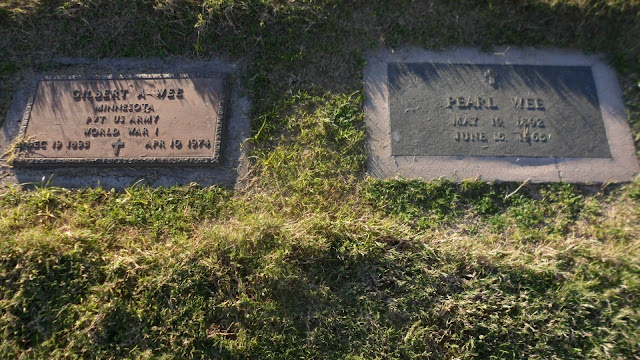World War I Takes a Brutal Toll
Gilbert Andrew Wee: 1895-1974
As I celebrated Independence Day this past weekend, I
reflected on the sacrifices made by members of the U.S. military over the
centuries. My second cousin once-removed Gilbert Wee was one of those soldiers
who paid a terrible price for our freedom. While serving in France during World
War I, he was seriously wounded and lost his arm at the elbow. This tragedy
changed his life.
Gilbert Andrew Wee was born December 19, 195 in Brown
County’s Lake Hanska Township in Minnesota. He was the ninth of the ten
children born to Anders Olsson Wee and Sigrid Olsdatter Skaar Wee. Anders was
my paternal great-grandmother Ragnhild Oldatter Ve Syverson’s nephew, so
Ragnhild was Gilbert’s great-aunt.
Anders died when Gilbert was only seven years old, so
Gilbert grew up helping his older brothers run the family farm. When he was 21
years old, he was drafted to serve in World War I. His draft card states that
he was single, and self-employed as a farmer.
Gilbert served as a private in Company C of the 160th
Infantry, 40th Division. According to his records on Fold3, he enlisted
May 25, 1918. His unit shipped out aboard the troop ship Nestor on August 8,
1918, setting sail from Brooklyn, New York.
 |
| Return transport aboard the Aeolus |
According to histories of the 160th Infantry,
when the 40th division arrived in France, they were sent to La
Guerche, a farming area in central France. They were used as replacements for
the front line from August through October, 1918. Gilbert was apparently
assigned to the 127th Infantry during that period, and was injured
on the battlefield.
A newspaper article from the December 11, 1918 issue of the
New Ulm Review reported that the Wee family had been informed that Gilbert had
been injured, and a later report stated that he had lost an arm.
Military records show that Gilbert was sent back to the
United States on the ship Aeolus on December 17, 1918, setting sail from
Bordeaux. The ship manifest states the passengers were “patients needing
dressings”. It appears he was initially
sent to the army hospital at Fort Snelling in St. Paul, Minnesota. He got a
furlough in February to go home to spend time with family before going back for
more treatment. He was discharged from the Army on May 22, 1919.
 |
| News photo of Gilbert recovering at Ft. Snelling in 1919 |
Gilbert’s return home can’t have been easy. The 1920 census
shows him living at home on the Wee farm near Hanska with his mother and three
unmarried brothers. His brothers are all working, two as laborers, while the
youngest brother, Willie, was running the farm, along with his mother.
Gilbert’s occupation is listed as “none”. They didn’t even include him as a
laborer on the family farm—he should have been able to contribute in some way
even with only one arm. Was there more wrong? Was he suffering from depression,
or was he still recovering from the amputation?
By the 1930 census, he was still living at home with his
mother and brother Willie, but at least was listed as a farm laborer, so he was
recognized as a contributing member of the family.
 |
| 1940 census, living in trailer camp |
At some point after 1935, Gilbert left his family, friends
and hometown, ending up by the 1940 census in a “trailer camp” in Paducah,
Kentucky. He was unemployed, presumably living off disability benefits. His
brother Willie had married in 1936. I suspect this may have prompted Gilbert’s
decision to move out; it would have been uncomfortable to be the fifth wheel in
the newlyweds’ home.
Gilbert moved on to
Arkansas before the onset of World War II, registering for the draft in Little
Rock on April 27, 1942. His draft registration card is a sad, grim record,
noting that the “person who will always know your address” was the postmaster
in Hanska—not a relative or friend. The reverse side of the draft card states,
“Right Arm (lost in France) off at elbow. Impediment in speech.” This is the
first notation of a speech impediment. Was this a new development, was it
another manifestation of his war injury or was it a lifetime affliction? The
draft card also notes how small a man he was—only 5 feet 3 inches tall, and 140
pounds.
Gilbert applied for a marriage license in Maricopa County,
Arizona on October 23, 1946. He stated that he was 51 and a resident of Hanska,
Minnesota even though he hadn’t been living there for nearly a decade. His
bride, Pearl Dennis, 52, stated she was a resident of Little Rock, Arkansas,
which was the city Gilbert lived in when he registered for the draft.
The couple apparently lived in Tucson for the rest of their
lives. They appear in a 1959 city directory, living in a small Spanish style
stucco house at 3543 Liberty Avenue, which was still their address when Pearl
died June 15, 1965.
At some point after her death, Gilbert moved into a nursing
home called Edna’s Christian Boarding Home, which housed several World War I
veteran residents. He died there April 19, 1974, and was buried at the South
Lawn Memorial Cemetery in Tucson. A newspaper article noted that other
residents at the Edna’s Home decorated his grave in 1976.
I can’t help but wonder how Gilbert’s life might have been
different if he had returned home from World War I unwounded. I feel that the
loss of his arm robbed him of more than just his arm. He seems to have returned
home a troubled man. I hope his later years in Tucson with his wife were
satisfying and happy. He deserved a happy ending after his suffering.
Sources:
https://history.army.mil/html/books/023/23-21/CMH_Pub_23-21.pdf
https://www.newrivernotes.com/topical_history_ww1_oob_american_forces.htm
https://www.fold3.com/image/604231172?rec=624696942&terms=wee,gilbert,a






No comments:
Post a Comment